[The following post was originally written some time back, when the referenced posts within were still “current.” For one reason or another, I never finished it off, which I now find unfortunate because it contains several factors that I want to use as a springboard. So I’m resurrecting this post, and ask that you excuse the reliance on ancient-in-webby-terms, yet still relevant, links.]
While I have actually addressed some of these points before, I feel the need to revisit them, because there are some salient details that deserve better attention.
Jerry Coyne at Why Evolution is True had the opportunity to publish an article in USA Today regarding the compatibility of science and religion. Short answer: they’re not compatible. And I really can’t disagree with that – science is about examining evidence, about testing ideas to see how well they apply, about not fooling ourselves, about determining a set of criteria to allow us to predict what will take place. Paramount in there is not having a foregone conclusion that you then try to justify or find support for. Religion, on the other hand, is about… well, it’s really hard to put a definition on it, to be honest. The best that can be said to apply almost universally is that religion involves organization around a non-materialistic cause. What’s missing, rather distinctly, is the ability to determine what this cause is, or even the reasons to promote it. In other words, latching onto the cause is first, and the why and how are not considered necessary criteria.
Is this useful, in any way? Does deciding on a conclusion first, then looking for ways to support it, make sense to anyone? Apparently, it does, because enough people engage in it, but call me crazy, I prefer to base conclusions on evidence and facts. I call this, “living with reality.” Amazingly, until we actually started determining knowledge in this way, we made little advancement as a species. Once we did, our knowledge base exploded. Historically, this is called the Enlightenment. I can’t help but wonder if that is a tongue-in-cheek dig, since the term “enlighten” almost always refers to religion or spirituality.
Naturally enough, the article received a rebuttal, not through USA Today, but on The Huffington Post, a site I link to reluctantly because their editorial standards are somewhat cavalier (read: flakey.) It’s not that I try to keep people from reading something I consider insipid, I just don’t think the site deserves any supporting traffic. No matter. Michael Zimmerman, who’s quick to tell you he founded something called the Clergy Letter Project, presented his case about why science and religion are compatible.
Except, he didn’t. He simply maintained that Coyne was wrong and ignorant of the vast majority of religious leaders who accept science and religion without issue. Feel free to read the article, and see where he actually addressed the issue of science and religion. See if, for instance, he managed to distinguish his case in any way from what Coyne addressed in the original article: that scientists being religious doesn’t indicate compatibility between the domains, anymore that married couples being unfaithful indicated compatibility between monogamy and adultery.
PZ Myers at Pharyngula had a grand old time with this, because Zimmerman was silly enough to put forth his Clergy Letter Project as an example of religious people accepting and even promoting science. Myers offered the following example, straight from the Project and written by Susan Andrews:
I have come to believe, in my own journey of faith, that God lives in the questions. I believe that seeking understanding with my mind is the preparation I need to trust with my heart. I believe that faith is the frontier beyond the limits of knowledge. I have started looking for portents – in the sky, in the newspaper, in the textbook, in the science lab, in the hospital room, in the darkness as well as the light. Yes, I have started looking for those signs of a God who is trying to do a new thing. And I have discovered that it is in the process, and in the journey, and in the questions that new knowledge and new understanding is usually found. Specifically in this peculiar American controversy about intelligent design, I have come to believe that evolution is intelligent design. And that the Intelligent Designer is the One whom I call God.
Okay, what? No, seriously, what the flying fuck was all that? If you’re familiar with religious writing, you’ll recognize it as typical, but if you’re expecting the promotion of science, you’re having some difficulties right now, I imagine.
There are eight sentences in that enthusiastic little avowal, and only one that does not specifically say, “I am finding god in every vague way I can” – that sentence is the one having to do with Intelligent Design. ID is very distinctive in that it has repeatedly and determinedly established that it has nothing to do with science, has no testing or experiments behind it, and in fact no research at all, no peer-reviewed papers, and most egregiously, no intelligent designer. No, not even inferred. The only evidence presented to support this lamebrained idea (it does not qualify as a theory) has been trashed from almost the moment it was proposed. ID actually had its day in court, the opportunity to demonstrate that it could qualify as an alternative theory to evolution – and failed miserably. One of the prime proponents even failed to show that he could be considered a working biologist.
As I mentioned above, this is common stuff from religious folk. Notice the lack of evidence, the lack of anything that could possibly be viewed by anyone else. Personal experience, or in this case, not even experience but simply interpreting everyday phenomena the way she wanted, is supposed to be the message. I was born in the mid-sixties, there was certainly no shortage of such messages then, usually involving various pharmaceutical substances. But even leaving behind the snark (it’s hard,) what does this provide for the human condition? How does this work? What does it promote, or predict, or correct, or control? Isn’t it self-indulgent to go looking for the answer that you wanted in the first place, and find it in totally meaningless ways? Is this what passes for religion and science?
One can certainly put forth the argument that such meaningless bullshit is a personal decision and choice, and not meant to provide anything for anyone else, just like having a favorite song. But that ignores the deeper, and very pertinent, issue of what religious motivation gets itself up to. Our politics in this country all revolve around whether any candidate fits with some public idea of religiosity – does that sound like a personal choice kind of thing? We constantly deal with new proposed laws that limit personal freedoms depending on some vague and totally inappropriate interpretation of scripture – I’m hoping no one considers this supportive of “personal choice.” Education standards are getting attacked constantly throughout this country to try and make them more compatible with religion – is that freedom to believe what you want?
Religion is faltering under the knowledge base that we have been building for a few centuries now, as more and more scripture becomes completely irrelevant to everyday life. Morality has long been established as a human trait, not induced by religion. Our origins can be traced back, in multiple agreeing disciplines, far beyond the supposed creation. Science, by finding answers in nature, points out how utterly wrong and misguided scripture and religion really are. And remember, science is not scriptural itself, it is simply a method of learning. If religion gets the short end of the stick when we look at the geologic or biologic record, nature is to blame.
So to try and counter this, people like Susan Andrews above put forth this festering pile of rotting chicken entrails that she considers a journey of faith. “It’s okay,” she says, “call religion any goddamn thing you want, and then you’re justified in trying to change people to be as godawful stupid as you are.” Let’s not forget that religion, as a motivator of actions, is supposed to be justified by being the will of ultimate authority. And lest this turn out to be total fantasy, we have feelgood mantras like that quoted above to try and dismiss the fact that the world itself calls it all a complete lie.
Because, god forbid (I’m a hoot,) somebody actually deal with reality, and with making decisions based on what works best. Fuck, that would require thinking! If god meant for people to think, he would have given us brains!
Let me give you an example of why this fails. Stem cell research is a promising line of medical advancement, because it deals with individual cells that can actually be instructed how to grow, what to produce. A stem cell can become a healthy kidney, a section of aorta, a skin graft, and so on, simply through the way it’s cultured. And with absolutely no rejection issues, because to the patient, it is their own tissue. Note that this is not “in theory,” because it’s already been done to a limited extent – what’s needed is the research to refine it and get consistent results. Some lines that work very well are what’s called embryonic stem cells, because they’re found in the early stages of an embryo.
If you’re one of those who is getting all huffy right now, put it aside, engage your brain instead of your emotions, and keep reading.
Federal funding for any research involving such tissue has been blocked for years now, which means that medical researchers intending to investigate this line of research cannot in any way be funded by government grants, or even be associated with any department that does. Hah, blocked that abortion issue handily, right?
Except that, embryonic stem cells are taken entirely from zygotes created during the process of In Vitro fertilization, otherwise known as “test tube babies.” This is a common, legal, and beneficial process taking place routinely in this country, and allows women with fertilization issues to still have children.
What happens is, it often results in zygotes, fertilized ovum or, if you prefer, early stage fetuses, being nonviable for later implantation within the uterus. But, they still have stem cells. Until this was discovered, the zygotes were donated to others or simply discarded.
Now that the funding block is in place, the zygotes are donated to others or simply discarded.
Lest I haven’t been clear enough, let me state it plainly: Some vote-seeking politicians have made some religious idiots happy by changing absolutely nothing in terms of fetal tissue creation, destruction, or disposal – they simply prevented any further benefit from coming of it. The religious idiots, with kneejerk reactions to hotbutton words like “embryo,” bought it entirely. In Vitro fertilization still goes on. And the politicians involved probably rode a nice voter wave of support for that bit of nonsense. Whether or not they understood the science involved, they knew how few constituents did. Wave the religious flag, and plenty of people climb aboard. It’s Pavlovian, really.
Now, it’s certainly okay to question what is ethical for the handling or treatment of fertilized ovum. But you know something? Religion provides no guidance on this. Seriously, look it up, see what scripture says about eggs and such. Haven’t found it? Neither has anyone else, because it’s not there. Whatever someone might think is the case does not come from scripture in any way. No less a religious authority than Thomas Aquinas argued that “ensoulment” came at “quickening,” or the period of fetal movement, about 40 days into the pregnancy. He certainly knew his scripture, but still didn’t have anything to base it on. And the real sticking point to all of this is, if life begins at conception, original sin damns all the non-saved babies to hell.
But if you treat the “soul” as simple mythology, and “original sin” as a cheap ploy to force piety, and the afterlife as wishful thinking, and consider “life” not the key factor, but perhaps “suffering,” what then? Does the idea of an embryo that won’t be born, lacking even a heart, brain, or nervous system, that can save other current yet endangered lives through medical research, sound like a good thing? Isn’t that what jesus was supposed to have done anyway? Isn’t that what killing abortion doctors is supposed to do?
And the nasty question, do we put more value on life that is small and vulnerable than we do on life that is conscious and active? The person that dies of kidney failure, waiting in vain for a compatible donor, has quite a few things that the embryonic stem cells do not: feelings, emotions, thoughts, memories, family, friends, responsibilities – oh, hell, let’s stop trying to make a complete list and simply call it, “a life.” Because that’s exactly how we define our own, isn’t it? Would we be happy to simply have a beating heart, a sparking brain, or cell division? That’s how the religious want to define “life,” but call me crazy, I like to have the ability to live it.
Even if you want to buy wholesale the doctrines of original sin and life beginning at conception, with eternal damnation unless the living being accepts salvation through an act of will, you still need to know that a high percentage of normally fertilized eggs (you know, people) spontaneously abort anyway, through no action of the parent or medical intervention. There’s already lots of babies in hell, and only one being put them there. That’s, of course, if the whole concept is correct, though since scripture doesn’t address when ensoulment occurs and is pretty vague on hell and original sin anyway, and there’s no evidence to support these pronouncements from religious philosophy, “correct” is not something that can be established in any meaningful way. Facts are not determined by discussion or consensus.
So this is where things break down. Even if you’re entirely devoted to following it, scripture doesn’t have rules to apply to every situation. No matter what, in many cases you’re simply on your own. You can’t abdicate thought – you have to be able to make reasoned decisions based on the factors involved in order to do the least harm, the most good. Interpretations, pithy sayings, and little rhymes aren’t any kind of substitute for reason. If anyone really finds this so hard to tackle, they aren’t required to – but they should then shut the fuck up and leave it to those that can.
Is that clear? If thinking is hard for you, don’t hurt yourself and let the professionals handle it. But if you feel up to tackling this gargantuan task, then give it a try. Hey, sometimes those cute little sayings and rhymes can be correct! Sometimes, the manufacturer’s claims for their product can be correct, too. The thing is, you won’t ever know for sure unless you examine them.
Here’s the really trippy part: that’s science. That’s all it is: examining, testing, proving. That’s why we use it. And that’s exactly why religion and science are incompatible. Bold assertions from scripture, pronouncements from religious leaders, and self-indulgent avowals do not affect, in any way, how the world works.
It’s easy to imagine lots of people vehemently arguing against that last statement. And I can show you an easy way to have them agree with it entirely. All I have to do is apply it to some religion other than their own.
Because the truth of the matter is, very few people have considered religion from the standpoint of comparing the multitudes of faith throughout the world and seeing which one has the most evidence, applies the best to what we experience every day of our lives, or predicts behavior and reaction, both human and non. Very few who dismiss ancient Greek and Norse religious structure (wholesale referred to as “mythology”) can demonstrate how their own religion has more function and evidence behind it than those, or any other. Few who consider muslims “fanatics” with weird ideas about 72 virgins have contrasted it with the resurrection and the bizarre events that supposedly saved us all from sin, only not really.
When we send a probe to Mars, which orbits that planet then soft-lands a soil sampler in a fairly precise location, and discover that the soil composition matches some Antarctic meteorites closely enough to determine, with a high degree of certainty, that Mars rocks have actually crashed on our planet, we have effectively trashed every collection of religious scripture ever written about how the Earth formed. When we create a vaccine against each season’s new strain of influenza virus, we have proven without doubt that common descent is a fact – if you question that, you should get educated as to what vaccines really are. When the nice little GPS voice in our cars accurately gets us right to our destination, we have established that the Earth is round, that electromagnetism travels at a fixed speed, that relativity accurately describes how time and gravity works, and that electron theory has lots and lots of uses. This is just a small sampling of our reliance on knowledge gained only in the last hundred years. It simply works.
It absolutely boggles my mind that anyone at all could possibly consider religion to hold any importance whatsoever to us today. All of this knowledge that we have gained through not trusting scripture and priests, but by simply examining the world in which we live, works for everyone, regardless of religion, salvation, working nervous system, or even cell division. It works whether we are here to witness it or not. There is no “word” to spread, no special action to engage in, and most especially, nothing to try and think of to explain why we have no evidence of it – or as seen above, how to change the definition of evidence to make us “right” all along. Intellectual honesty requires simply seeing how the world works. Anything else is abject denial.
It is long past time to abandon it. We’re bigger than that now.
And finally, we go back to that original question, about the compatibility of religion and science. I feel the need to point out that the question itself can really only be asked because science works, undeniably so, but people are simply too reluctant to give up the faith. So they try, really hard, to find ways to make religion work in a world that has no use for it. They rationalize it, and try to reduce the influence they claim it has, and fight desperately to change scripture into something that might, if you squint and turn your head sideways, maybe slightly kinda matches a loose definition of some facet of proven scientific knowledge. But show me in what way this is different from, “Smoking relaxes me,” and, “I only drink socially.”
Yes, of course it’s addictive behavior. I won’t bother getting into the idea that somebody personally finds religion beneficial to themselves, though I bet I can trash that idea handily. The public face of religion has not ever, in any point in history, been about personal benefit – that’s simply the whiny excuse that is resorted to when someone (like me) is crass enough to point out that denial of rights and broad condemnations are being issued on the basis of a vacuous and wildly inaccurate collection of old scripture. The list of justifications for religious belief is exceedingly long, and yet somehow lacking in any quality approaching “reason.” It practically makes me wonder if the same species actually came up with both scientific principles and religion, since one is enormously functional and the other based solely on emotional appeal.
No, seriously. Try and find the evidence supporting religion as a functional source of information and guidance. Scripture admitting openly and distinctly that it’s the word of god? Yeah, it also says to avoid women when they are “unclean” (while, of course, not allowing them to have any rights that a man does,) where to obtain slaves properly, and that beating children is recommended. The amount of bloodshed and strife is astounding, really, and then we get treated to someone telling us that this is a loving god. I’m not into sado-masochism myself, thanks all the same. And I just realized I also answered the “ethical guidance” argument too, something I’ve never really needed in the first place – I can determine ethics through both empathetical tendencies built right into our species, and using that ol’ brain up there. It’s not freaking calculus, you know.
The desperation to substantiate belief goes so out-of-control that people actually resort to arguments such as “most of the world is religious” (an interesting argument when religious conflict takes up so much of our species’ time,) “the universe/laws of physics are too fine-tuned for us to be an accident” (as long as we don’t go into space without protection against temperature, null atmosphere, and fatal radiation, or go underwater, or go too high up the mountains, or try to live in high desert,) and “I can imagine a perfect being so there must be one” – fuck, no, seriously, this is the heart of the Ontological Argument, considered by those same desperate people to be a leading philosophical argument for religion, followed closely by the Kalam/Cosmological Argument. Even if they made any sense at all (they don’t,) neither one actually supports religion in the way that anyone wants to practice it. There are an awful lot of missing steps between something being responsible for First Cause, and the loving-yet-infinitely-punishing-because-you-didn’t-worship-me-properly god with which most people concern themselves. This is obviously not about making sense, or even finding a personal outlook that works. This is about rationalizing actions and prejudice so that, god forbid, we never admit that we’ve been wrong.
That’s fucked up. There really is no other way to put it.
Coming soon: the repercussions of saying that last sentence.























































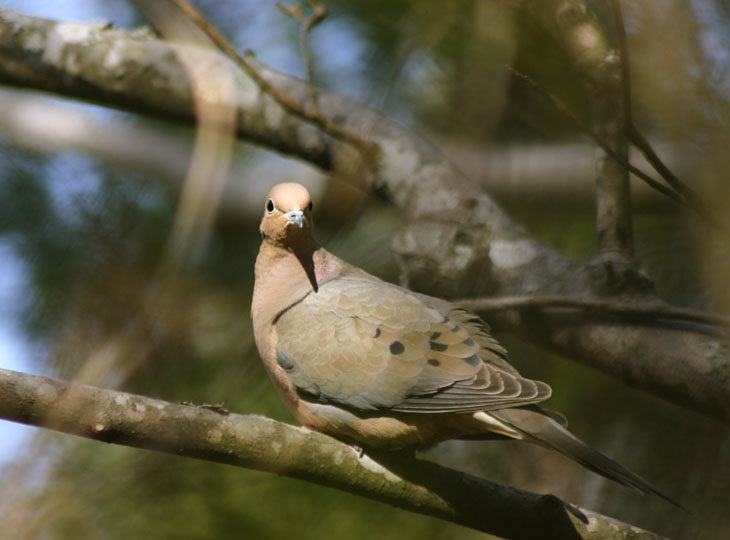
 This pattern told me what was happening, confirmed after a shift in my position revealed the female in the fork, maintaining and rearranging the new nest as the male brought home materials. The location was excellent from their standpoint, but less so from this nature photographer’s, for exactly the same reason: it was extremely difficult to see. Hampered slightly by the garden trails I was requested to keep to, I had a difficult time getting any vantage that allowed a clear look past obscuring branches and foliage, but she obliged enough to sit up a little higher and appease the paparazzi, so I didn’t have to fetch a ladder or helicopter. Since she barely moved from position, I suspect she was either laying or already in possession of their eggs. For any birder seeking to spot nests, this is perhaps one of the easiest birds to choose, because their wings make a distinctive corduroy-like “wheep”ing sound that makes them effortless to follow. They’re also relatively slow fliers and fairly plump, which is why some people refer to them as “Accipiter Food” – accipiters being the birds-of-prey in North America that catch other birds on the wing. One could be blind and snag a mourning dove…
This pattern told me what was happening, confirmed after a shift in my position revealed the female in the fork, maintaining and rearranging the new nest as the male brought home materials. The location was excellent from their standpoint, but less so from this nature photographer’s, for exactly the same reason: it was extremely difficult to see. Hampered slightly by the garden trails I was requested to keep to, I had a difficult time getting any vantage that allowed a clear look past obscuring branches and foliage, but she obliged enough to sit up a little higher and appease the paparazzi, so I didn’t have to fetch a ladder or helicopter. Since she barely moved from position, I suspect she was either laying or already in possession of their eggs. For any birder seeking to spot nests, this is perhaps one of the easiest birds to choose, because their wings make a distinctive corduroy-like “wheep”ing sound that makes them effortless to follow. They’re also relatively slow fliers and fairly plump, which is why some people refer to them as “Accipiter Food” – accipiters being the birds-of-prey in North America that catch other birds on the wing. One could be blind and snag a mourning dove…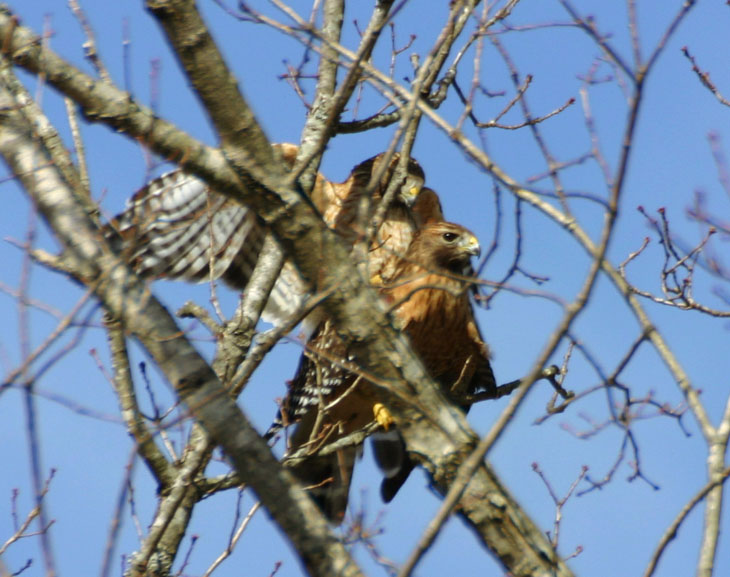
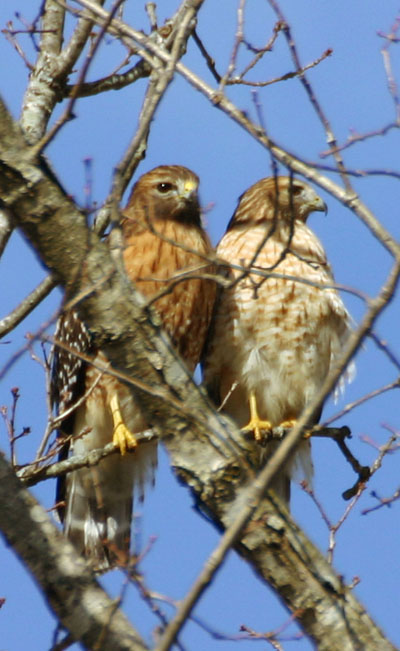 Afterward, they perched together, and I’d like to anthropomorphize even more and claim that this is the equivalent of small talk, but more likely, they were watching the nearby crows who had worked themselves into apoplexy (as crows are wont) because of the hawks’ proximity. This area is highly competitive, with songbirds, crows, and raptors all using it for nesting and food, and none of them liking the others nearby. The crows are the most obnoxious, often ganging up to harass other birds they consider a threat, but the raptors can usually hold their own. With the frequent displays of territorial and mating calls, from both the red-shouldered and red-tailed hawks, the crows have been maintaining a constant presence, only not too close – don’t piss off a hawk during Singles’ Night. About the only ones not appearing to react to others are the woodpeckers, who have been continually going about their business while all of this goes on, sometimes noisily, around them.
Afterward, they perched together, and I’d like to anthropomorphize even more and claim that this is the equivalent of small talk, but more likely, they were watching the nearby crows who had worked themselves into apoplexy (as crows are wont) because of the hawks’ proximity. This area is highly competitive, with songbirds, crows, and raptors all using it for nesting and food, and none of them liking the others nearby. The crows are the most obnoxious, often ganging up to harass other birds they consider a threat, but the raptors can usually hold their own. With the frequent displays of territorial and mating calls, from both the red-shouldered and red-tailed hawks, the crows have been maintaining a constant presence, only not too close – don’t piss off a hawk during Singles’ Night. About the only ones not appearing to react to others are the woodpeckers, who have been continually going about their business while all of this goes on, sometimes noisily, around them.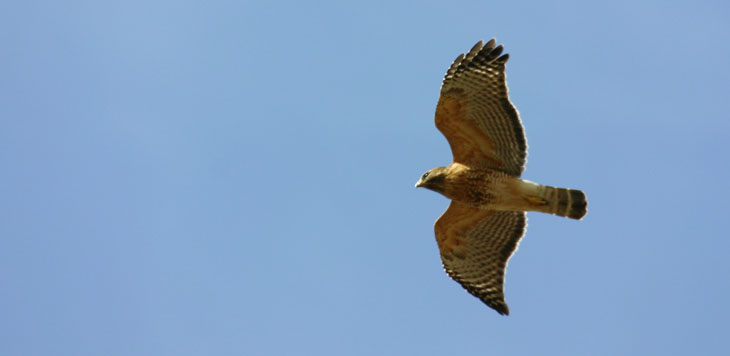
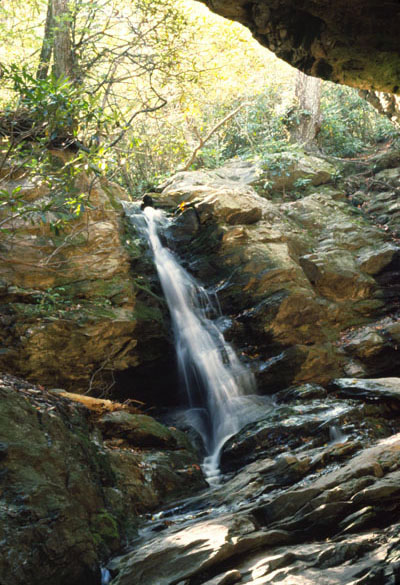 So, one of the images in my slide collection is seen, full-frame, at left – this is the small cascade of a feeder stream that leads into Window Falls at Hanging Rock State Park, North Carolina. And yes, it appears I didn’t concentrate on keeping the camera level.
So, one of the images in my slide collection is seen, full-frame, at left – this is the small cascade of a feeder stream that leads into Window Falls at Hanging Rock State Park, North Carolina. And yes, it appears I didn’t concentrate on keeping the camera level.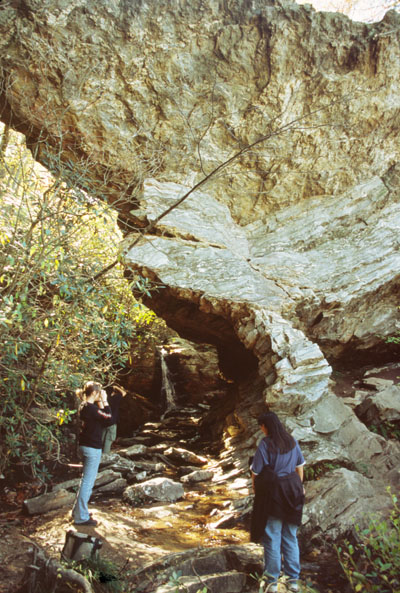 Or maybe not. The women (I don’t know them) aren’t really supporting either angle, and when I tried tilting the image to see which angle looks most accurate, either one works. The woman on the left has her back arched, possibly against leaning forward, while the woman on the right could be leaning to see around the outcropping. The rock strata makes things even worse. The foliage seems to be supporting the original angle from above, but since this is a mountaintop, it could be leaning over from winds and erosion at the edge of this cut. While the top image was definitely taken on a tripod, this one was likely shot freehand candidly. This image was really no help at all. Maybe gravity is all messed up – I seem to recall this happening in various places around the world…
Or maybe not. The women (I don’t know them) aren’t really supporting either angle, and when I tried tilting the image to see which angle looks most accurate, either one works. The woman on the left has her back arched, possibly against leaning forward, while the woman on the right could be leaning to see around the outcropping. The rock strata makes things even worse. The foliage seems to be supporting the original angle from above, but since this is a mountaintop, it could be leaning over from winds and erosion at the edge of this cut. While the top image was definitely taken on a tripod, this one was likely shot freehand candidly. This image was really no help at all. Maybe gravity is all messed up – I seem to recall this happening in various places around the world…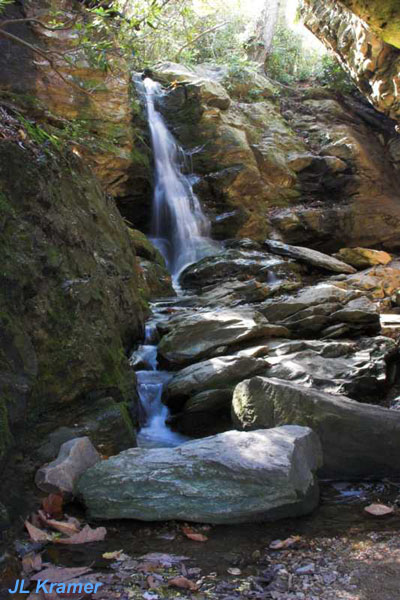 UPDATE: He bit ;-). JL Kramer was also present for this trip, and took his own pics of the same cascade, seen here at left. We see that I did indeed have the camera tilted, just not half as much as it appears. Kramer’s photo matches the angle that I have in the second pic (but has a much nicer composition than my first – the foreground rock is a great element,) so it appears I wasn’t meticulous about leveling the camera. I’m not terribly surprised – there was nothing to align it against or with nearby, but still…
UPDATE: He bit ;-). JL Kramer was also present for this trip, and took his own pics of the same cascade, seen here at left. We see that I did indeed have the camera tilted, just not half as much as it appears. Kramer’s photo matches the angle that I have in the second pic (but has a much nicer composition than my first – the foreground rock is a great element,) so it appears I wasn’t meticulous about leveling the camera. I’m not terribly surprised – there was nothing to align it against or with nearby, but still…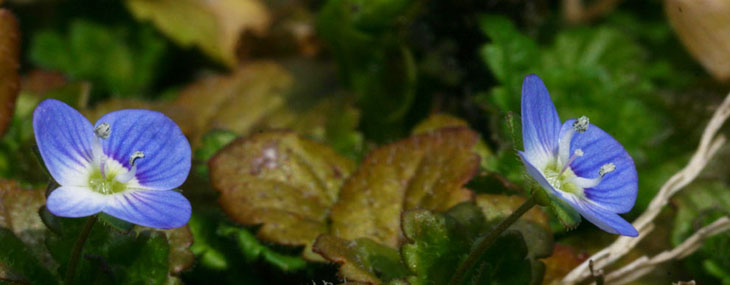
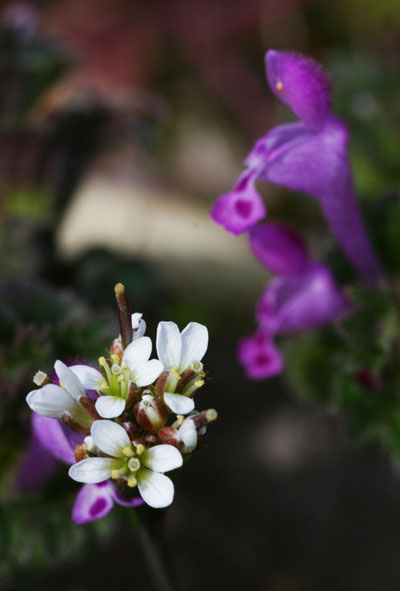 But we’ve had a couple of lovely days here recently, and while the grass is still brown and trees have not started to bud, I’ve been able to find some nice signs of “spring,” especially if I kept my sights low – in this case, down at the ground at the macro scale. While one of my two lens issues will soon be resolved, I decided to try another avenue for closeup and macro work. The 80mm macro lens for the Mamiya medium format camera isn’t intended to be used on any Canon EOS cameras, but mating together a body cap for the EOS and a rear lens cap for the Mamiya makes them fit together just fine, and the Mamiya has a auto/manual aperture switch that overcomes the lack of aperture control from the EOS system. Exposure is far from automatic, but this is simply one example of what can be accomplished if you’re willing to experiment. Both the flowers above and at right are barely visible while standing directly over them, measuring less than a centimeter at most. I don’t even know where to begin to look these up, so if anyone wants to chime in and tell me what these are, I’d be more than happy.
But we’ve had a couple of lovely days here recently, and while the grass is still brown and trees have not started to bud, I’ve been able to find some nice signs of “spring,” especially if I kept my sights low – in this case, down at the ground at the macro scale. While one of my two lens issues will soon be resolved, I decided to try another avenue for closeup and macro work. The 80mm macro lens for the Mamiya medium format camera isn’t intended to be used on any Canon EOS cameras, but mating together a body cap for the EOS and a rear lens cap for the Mamiya makes them fit together just fine, and the Mamiya has a auto/manual aperture switch that overcomes the lack of aperture control from the EOS system. Exposure is far from automatic, but this is simply one example of what can be accomplished if you’re willing to experiment. Both the flowers above and at right are barely visible while standing directly over them, measuring less than a centimeter at most. I don’t even know where to begin to look these up, so if anyone wants to chime in and tell me what these are, I’d be more than happy.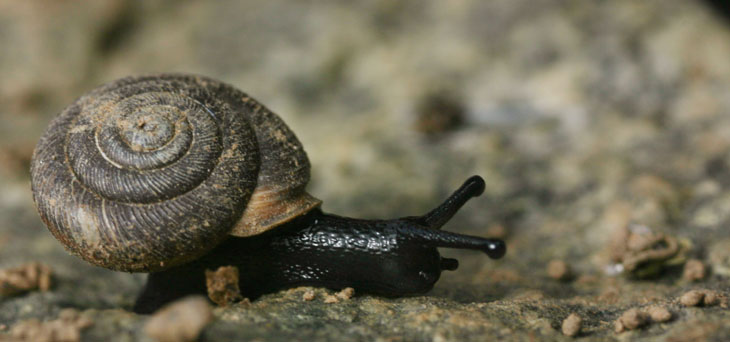
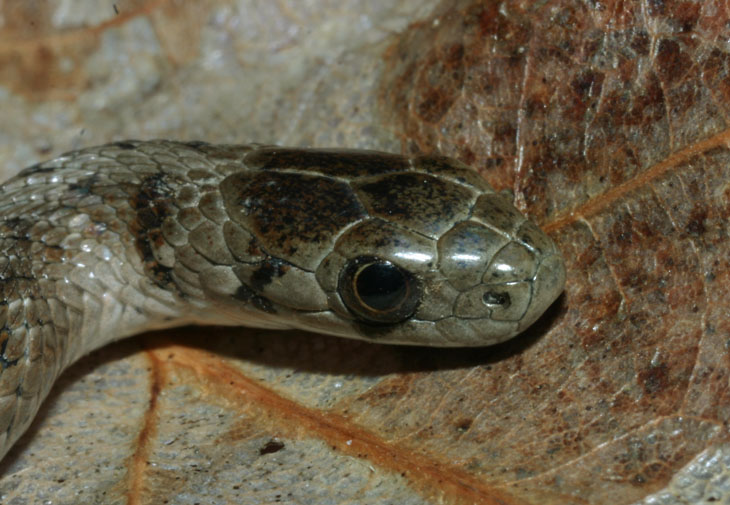
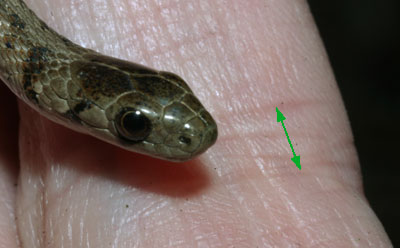 If it helps, here’s another view of my model, clasped gently in my left hand while the right juggled the camera. My little finger is the background (looking disturbingly aged from this close,) and the green line spanning the crease of the first joint is a measured 4mm – an average pencil measures 7mm. Even if these snakes were venomous, there wouldn’t be anything they could actually bite except maybe your earlobe. Since their diet is grubs and worms, it’s safe to say there isn’t any other species that pales at the sight of a brown snake, so it’s embarrassing that too many people freak out at the mere sight of a snake and feel inclined to kill them. It’s like being scared of fish.
If it helps, here’s another view of my model, clasped gently in my left hand while the right juggled the camera. My little finger is the background (looking disturbingly aged from this close,) and the green line spanning the crease of the first joint is a measured 4mm – an average pencil measures 7mm. Even if these snakes were venomous, there wouldn’t be anything they could actually bite except maybe your earlobe. Since their diet is grubs and worms, it’s safe to say there isn’t any other species that pales at the sight of a brown snake, so it’s embarrassing that too many people freak out at the mere sight of a snake and feel inclined to kill them. It’s like being scared of fish.
 Those little pixels just barely visible now provide an impression of what they really are: a couple of men on a scaffolding on the side of the building (doing what, I’m not really sure, but better them than me.) Now do you get an idea of the scale? The blue starfield portion of the American flag painted on the side of the building is the size of a basketball court; each stripe is the width of an average road lane. The VAB stands 160 meters (526 feet) tall, not quite half the height of the Empire State Building, but four times the volume. Even more interesting, it is 55 meters (180 feet) higher than the highest ground elevation in Florida – yes, the state is very flat; swamps don’t tend to pile up very high.
Those little pixels just barely visible now provide an impression of what they really are: a couple of men on a scaffolding on the side of the building (doing what, I’m not really sure, but better them than me.) Now do you get an idea of the scale? The blue starfield portion of the American flag painted on the side of the building is the size of a basketball court; each stripe is the width of an average road lane. The VAB stands 160 meters (526 feet) tall, not quite half the height of the Empire State Building, but four times the volume. Even more interesting, it is 55 meters (180 feet) higher than the highest ground elevation in Florida – yes, the state is very flat; swamps don’t tend to pile up very high.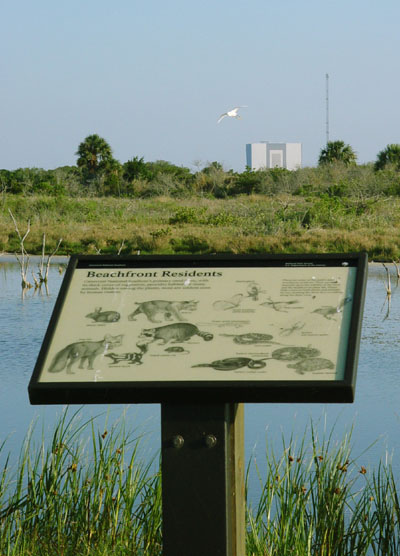 The northern part of the island that holds the Cape is Merritt Island Wildlife Refuge,
The northern part of the island that holds the Cape is Merritt Island Wildlife Refuge,